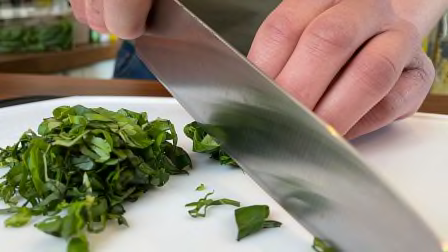5 Things Our Food Safety Expert Would Never Do
Consumer Reports' director of food safety, James Rogers, explains why he would never wash his chicken
I can’t say I’m the most conscientious about food safety. I’m negligent about expiration dates, I leave rice in the pot overnight (which can cause food poisoning), and I love a raw bar (read about the issue with this below). But after having food poisoning a handful of times in my life, I’m starting to wonder if maybe it’s time for me to start thinking about food hygiene more critically than I have in the past.
James Rogers, PhD, the director of food safety research at Consumer Reports, tells us the five things he’d never do—all things that keep him safe and salmonella-free. Because who has time to sit next to the toilet for 24 straight hours? I certainly don’t.
@consumerreports Stay safe and salmonella-free with these tips from James Rogers, CR’s director of food safety. Learn more at cr.org/food5things. #foodtok #foodsafety #5thingsiwouldneverdo
♬ original sound - Consumer Reports
1. Wash Raw Chicken
“The number one thing I’d never do? I would never wash my chicken. Why? Because washing your chicken does not remove harmful bacteria and you have a chance of contaminating your kitchen and any food that is left out.”—James Rogers
2. Eat Certain Dairy Products
“The second thing I would never do is drink or eat anything that contains raw milk. Raw milk is not pasteurized. And while there are a number of people who prefer raw milk over pasteurized milk, because it’s not pasteurized, the bacteria that are in there can survive and cause serious foodborne illness.”—J.R.
Raw milk might be especially creamy and rich, but it’s not worth the risk. Raw milk isn’t pasteurized, which means that it hasn’t been heated to a certain temperature to kill off pathogens. Cheese made from raw milk can be risky, too. The Food and Drug Administration has warned people not to drink raw milk because there have been outbreaks linked to its consumption in the past. People can experience stomach cramps, diarrhea (fun!), and vomiting after getting sick from raw milk, but the FDA says that sometimes even more serious conditions can occur, such as Guillain-Barré syndrome, a rare disorder that can cause paralysis, and hemolytic uremic syndrome, a disease that can cause kidney failure.
The Centers for Disease Control and Prevention says that most of the nutritional benefits from raw milk are also available in pasteurized milk—without the risk of food poisoning. So might as well stick with the safe stuff, right?
3. Use Plastic in the Microwave
“I’d never microwave my food in plastic containers. There are harmful chemicals in plastic that can migrate into your food during microwaving. So it’s best to use glass.”—J.R.
Barbiecore may be hot right now, but I’m not down for actually becoming plastic myself. That said, most of us consume a lot of plastic every year. The average American drinks, breathes, and eats 74,000 microplastic particles a year, according to a 2019 research review.
Some chemicals used to make plastics can leach into food when heated, so by not heating up your food in a plastic container, you’re cutting down your consumption of these chemicals. Transfer your food into glass—and never put metal in the microwave, either, because it can start a fire and completely destroy the thing (as I discovered as a child when I and my teenage babysitter had a grand old time putting a CD in my parents’ microwave).
4. Snack on Raw Sprouts
“I’d never eat raw sprouts. There have been a number of foodborne illnesses linked to raw sprouts. Unless you cook them, such as in stir-fry or blanche them, you stand the chance of catching a foodborne illness.”—J.R.
When you think about food poisoning, you probably think about chicken and fish, and sure, that’s definitely a problem, as this article shows. But some vegetables can be contaminated, too. Numerous salmonella and E. coli outbreaks have been linked to raw sprouts, and the CDC recommends that consumers cook sprouts to decrease the chance that you and your family or guests will get sick. Kids, pregnant people, and those with compromised immune systems are particularly at risk.
5. Eat Raw Meat
“And number five, I’d never eat any form of raw meat. I know my sushi lovers will not like this, and I know sushi has been shown to be healthy for you. But because it is not cooked, that means that an important kill step to kill any pathogenic bacteria has not been done. Because of this, you can catch a serious foodborne illness, and this is especially important for pregnant people whose fetuses are more sensitive to foodborne illness and infections.”
—J.R.
Well, shucks. Count me in as one of those depressed sushi lovers who will now look upon their beloved salmon avocado roll with anxiety. In fact, I don’t just love sushi—I simply can’t get enough ceviche and crudo, either. But a bad batch (and, yes, I’ve actually experienced this) can send you on a super-fun 24-hour trip to the toilet. Raw fish can be contaminated with Vibrio vulnificus, which is a bacteria that lives in coastal waters, as well as listeria or salmonella. Raw fish can also contain parasites that are killed at very low temperatures, which is why FDA guidelines recommend that most fish meant to be served raw must be frozen first. James says that he wouldn’t eat sushi, though others can opt to if they want, because the risk is manageable if restaurants and home cooks follow safety precautions when preparing the fish (whew!). But if you’re immune compromised, a child, a senior, or pregnant, the risks can be more serious. Check out this list of healthy and safe—when cooked—fish to eat.




















